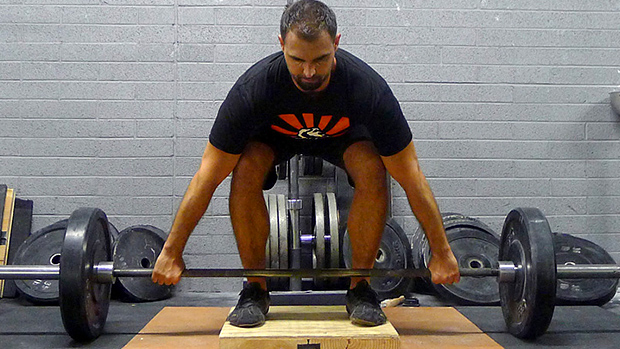Do You Have a Tight Piriformis?
The piriformis is a deep hip rotational muscle that turns your leg out. It sits under your glutes and runs from the base of your spine to your outer hip. When severe enough, a tight piriformis can cause a stabbing or dull ache in your butt that makes a long car trip miserable.
A tight piriformis also creates SI joint pain and dysfunction since it attaches to the sacrum (the S in SI joint). Needing frequent chiropractic adjustments is another sign something isn't right. In severe cases it can irritate your sciatic nerve causing numbness and pain down the back of the leg.
Here's the thing: No amount of stretching and foam rolling is going to fix it. The piriformis is simply trying to stabilize your hip because the other muscles that should be doing the work fail to meet the demand. It's the overload principle, but in a bad way for your piriformis.
The glute max is king when it comes to taking stress off the piriformis. Think hip thrusts, squats, and deadlifts. But what if you're working your glutes hard every leg day and you still have a tight piriformis? Then we need to dig a little deeper into your hip balance to find the solution.
The TFL (tensor fasciae latae) is a hip flexor muscle that inserts into your IT band. It helps you raise your leg, abduct, and internally rotate. The problem is, it has a great line of pull to be very influential at the hip. In the presence of an ineffective glute max, this results in a tug-of-war with the piriformis that will cause the piriformis to tighten down.
The foam roller has gotten a bad rap lately, but this is one instance where rolling will help. Pre-roll your TFL prior to your glute exercises to help shut it down. This will allow more glute max activation.

Lack of hip internal rotation is also a huge factor. Sure, you can fix the occasional piriformis syndrome with band walks and clams, but most of the time the hip in question actually lacks controlled internal range. This is part of what's causing that piriformis to hold so tightly.
What causes you to lose hip internal rotation? There are a few possibilities: lack of core strength, decreased iliacus firing, and decreased arch strength.
Your core acts as a primary stabilizer for the top of your pelvis and your spine. If your core is weak or imbalanced, the muscles in your hip will have to work overtime to compensate. It doesn't matter that you can do 100 sit-ups either. We're talking about the type of core strength that holds you stable through movement, especially during a squat.
Do you flip into an excessive anterior tilt in your squat? Then your core is weak. To fix this issue, focus on more work in the transverse plane, having the core resist motion. Too much anterior tilt really sets off the piriformis. An effective exercise is lunges with rotation because you're not only taking the hip into internal rotation, you're activating the core in the transverse plane as well.
Coaching Notes:
- Do a lunge, equal weight on both the front and back foot.
- Keep your knees facing straight through the rotation.
- Don't allow the rotation to come from your lower back, only your hip.
- No dumping forward into an anterior tilt.
Back to glute strength. When you have weak glutes, you tend to clench or hold them tight. A muscle must fully lengthen to get stronger, which is why clenching makes you weaker in the long run.
To help stop the clenching, focus on eccentric (negative) loading. A very controlled squat down to a box works great for this. Make sure to keep your core activated the entire way and never lose pelvic alignment. Focus on feeling your glutes lengthen, keep moving your surface (the box) lower to increase the challenge.
Now let's bring in the iliacus and get your femur back in the socket. Ahhhh, sweet piriformis release. A release gained by opposing muscle always holds better than a release gained by a foam roller. This is the single best exercise for immediately releasing the piriformis and providing balance to the hip. To really get your iliacus to kick in, try this exercise. In this one, your femur must move back in the socket, which means your piriformis must release.
Coaching Notes:
- Keep your core engaged. Don't flip into an anterior tilt.
- Don't lose your adductor as you pull back.
- No TFL, glute max, or piriformis activation during this exercise. These guys must stay relaxed. Turning a muscle off is often the hardest part.
Lastly, if you never work your arches, your feet will collapse in. If your feet collapse in, the external rotators in your hip (piriformis) will overwork to compensate. Once again, the piriformis is just trying to help out and that's why it's so tight. If your gym will let you, lift barefoot. Make sure you keep your big toe firmly planted on the ground during lifts. When your toes pop up during a squat, it deactivates the core and turns on the paraspinals as counterbalance.
A tight piriformis is not the fault of the piriformis, but a symptom that your hip is not firing like it should. Instead of treating the symptoms, i.e. stretching and foam rolling, get to the root cause. This multifactorial cause includes building rock solid core stability, building glute max and arch strength, and gaining hip internal rotation. Optimal strength and muscle balance lead to heavier lifting and happier car trips.




